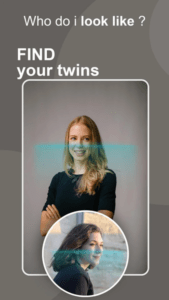Scan Images and Find Your Twins
In the digital age, one of the more intriguing possibilities is discovering people who look like you across the globe—your “twins.” With advancements in AI and image recognition technology, finding these lookalikes has become much easier. The keyword here, “Scan Images and Find Your Twins”, refers to a trend where users upload their photos, and AI scans through large databases to find people with similar facial features. This technology has captured people’s curiosity and is increasingly popular due to its novelty and its connection to our intrinsic fascination with identity and resemblance.

Scan Images and Find Your Twins
The concept of “Scan Images and Find Your Twins” leverages machine learning and neural networks to analyze and match facial features. Various platforms offer these services, and while each has unique algorithms and user experiences, they generally work by comparing uploaded photos against vast image databases. The result is often a list of people who closely resemble the user, and in some cases, it’s surprisingly accurate.
These services are used for multiple purposes: curiosity about finding lookalikes, social media sharing, and even practical uses like identifying family members or historical figures with similar features. The process is designed to be simple and fast, allowing anyone to participate.
Specialty of Scan Images and Find Your Twins
The uniqueness of “Scan Images and Find Your Twins” technology lies in its ability to harness AI for personal connection and entertainment. Here are some standout features that make this technology special:
- Advanced Facial Recognition: Using deep learning models, these platforms analyze unique facial markers and generate highly accurate matches.
- Large Databases: Some services have access to millions of images, significantly enhancing the probability of finding a close match.
- User-Friendly Interface: Most applications are easy to navigate, making it accessible even for non-technical users.
- Real-Time Matching: The process usually takes only a few seconds, allowing users to see results almost immediately.
- Fun and Social Media Sharing: This experience is often about the fun factor, with many users sharing their results on social media platforms.
- Privacy Considerations: Many platforms now offer options to delete uploaded photos after the scan, which appeals to privacy-conscious users.
This mix of advanced technology, ease of use, and social appeal has made “Scan Images and Find Your Twins” widely popular.
Uses of Scan Images and Find Your Twins
The ability to scan images and identify twins has multiple practical, social, and even research-oriented uses. Here’s a closer look at some common applications:
1. Entertainment and Social Sharing
- Curiosity Fulfillment: Many people are naturally curious about finding someone who looks like them, and this technology provides an easy way to explore that curiosity.
- Social Media Engagement: People love to share their lookalike results on platforms like Instagram, Facebook, and Twitter, sparking fun conversations with friends and followers.
2. Genealogical Research
- Family Connection: Some platforms can find family members by analyzing facial markers that run within families, aiding users in genealogical research.
- Historical Exploration: Users interested in ancestry can find people with similar features from past generations, sometimes even linking to historical figures.
3. Marketing and Engagement Tools
- Brand Engagement: Some companies use “Scan Images and Find Your Twins” technology for brand interaction, creating playful experiences that enhance customer engagement.
- Customer Insight: Businesses can gain insights into demographic similarities among users through facial similarity analysis, helping in targeted marketing.
4. AI and Data Analysis Research
- Improving Algorithms: These services provide data that can help improve AI facial recognition technology for various fields, from security to virtual reality.
- Facial Diversity Studies: By analyzing the distribution of facial features across populations, researchers can gain insights into human diversity and evolution.
5. Personalized Art and Products
- Portraits and Artwork: Some users turn their twin images into custom portraits, creating keepsakes or unique artwork that captures the likeness of two unrelated people.
- Custom Merchandise: Companies are now offering personalized items, such as t-shirts or phone cases, featuring the user’s twin match.
Main Theme of “Scan Images and Find Your Twins”
The main theme of the “Scan Images and Find Your Twins” concept centers on the human need for connection and self-exploration. Many people are curious about their identity and unique features, and this technology allows them to see themselves from a new perspective. By finding their “twins,” users experience a sense of global connection, realizing that someone, somewhere, resembles them. This concept combines the enjoyment of novelty with advanced machine learning technology, making it both an intriguing and educational tool.
From an E-E-A-T perspective, platforms that provide these services must maintain a high standard of expertise and accuracy in facial recognition, authoritativeness in handling and protecting user data, and trustworthiness through transparent privacy policies. This technology taps into the universal appeal of personal discovery, while also connecting users in unexpected ways, offering a combination of fun, science, and identity.
Pros and Cons of Scan Images and Find Your Twins
| Pros | Cons |
|---|---|
| Fast and Easy to Use: The process is quick and requires minimal input from users. | Privacy Concerns: Some users worry about their images being stored or misused. |
| Highly Entertaining: The novelty and excitement of finding a twin make it a fun experience. | Inaccuracy: Not all results are perfect, and some matches may be questionable. |
| Free Options Available: Many platforms offer free scans with optional paid features. | Data Security: Users need to trust that platforms won’t misuse personal data. |
| Large Database: More images increase the chance of finding a realistic match. | Limited Practical Use: Primarily for entertainment, with few practical applications. |
| Option for Anonymity: Many platforms allow users to delete photos after scanning. | Variable Quality: Different platforms offer varying levels of accuracy and features. |
Conclusion for “Scan Images and Find Your Twins”
In conclusion, “Scan Images and Find Your Twins” technology provides a unique and engaging way for users to discover lookalikes. This combination of advanced AI, facial recognition, and vast databases has created a service that appeals to many people for both its entertainment value and its novelty. While concerns around privacy and data usage remain, platforms that prioritize secure, transparent practices are gaining the trust of users. This technology is a wonderful tool for social interaction and personal exploration, allowing users to experience the world from a new perspective by finding their “twins” worldwide.
The ability to find your twin might be a lighthearted pastime, but it also taps into deeper questions of identity, connection, and even genetics, showing the evolving role of AI in our daily lives. With continual improvements in accuracy and privacy, we can expect “Scan Images and Find Your Twins” technology to remain popular and relevant in the coming years.
FAQs for “Scan Images and Find Your Twins”
1. Is it safe to upload my photo to these platforms?
Most platforms prioritize user privacy and offer options to delete photos after scanning. However, it’s always important to read the privacy policy before using the service.
2. How accurate are the results from twin-finding platforms?
While many platforms are highly accurate, the quality can vary depending on the technology and database size. Some results may be more accurate than others.
3. Are there any costs associated with using twin-finding services?
Many platforms offer free basic scans but may charge for advanced features or additional benefits, such as unlimited searches or ad-free experiences.
4. What happens to my data after I use the service?
Some platforms delete images immediately after scanning, while others might retain data for algorithm improvements. It’s essential to choose a trusted platform with transparent policies.
5. Can this technology identify actual relatives?
Although primarily designed for entertainment, some platforms do have family-finding capabilities, analyzing genetic facial markers to identify potential family relations.



